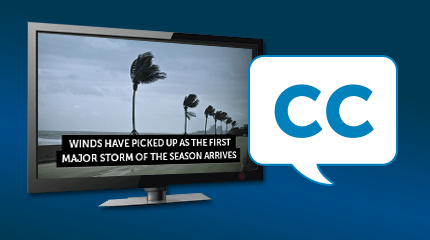Closed captioning has been with you most (or all) of your life. You may not have realized it but closed captioning began all the way back in 1972. It became mandatory along with the Americans with Disabilities Act in 1990. Originally intended to help those with hearing problems, a generation of TV viewers grew to enjoy the captions as a way to watch TV while someone else in the room was making noise, vacuuming, on the phone, or what have you.
Closed captioning works, except when it doesn’t
Closed captioning was doing great at first. The closed caption stream was built into the standard definition connections on every TV. That meant TV makers could (and did) set their TVs up so captions would appear whenever you muted the volume. This meant a lot more people were exposed to closed captions, and they found all sorts of reasons to like them. In a world where you couldn’t pause live TV and few people did any recording, it let you multitask more efficiently.
The first challenges with closed captioning came in the mid-2000s. Because the HDMI cable standard did not create an automatic path for passing closed captioning information to the TV, it was up to manufacturers to build in their own closed captioning decoders and put them into set-top boxes. This was a minor bump in the road but it often meant that since the cable box was doing the captioning, the friendly option to enable captions when pressing MUTE on the TV remote went away. While the faithful complained, the rest of the world moved on and a lot of people don’t even remember that you could do this at one time.
Captioning for streaming
Streaming video brought new systems for captioning and new requirements. Most commercially produced videos that look and act like regular TV shows are captioned, and rules have been in place since 2012 that say that anything that even smells remotely like a TV show has to be captioned. Plain-old YouTube videos don’t require captioning, but in most cases you’ll find that YouTube itself will automatically caption videos for creators. The captions may not be perfect but they do work.
You may have also noticed that many autoplay videos (such as those on TikTok and other social) are captioned, since they play without sound. The smart video producer will build in captions so the meanings are not lost.
However, all of this blurs the lines between “open captions,” “closed captions,” and “subtitles.” Open captioning is technically captioning that’s on all the time. The original meaning of “closed captioning” implied you had to buy special hardware to see the captions, but the ADA changed that.
Subtitles are really the issue here
Technically most of what you call “closed captions” today are actually subtitles. You, the average TV viewer, probably wouldn’t be able to tell the difference, but there are subtle legal distinctions. If the letters are not on a black background and don’t take up a certain percentage of the screen, they’re technically subtitles. In most cases, what you’re looking at is subtitles, and many devices there are both options. Regular folks may not know why this is, but the thing is that closed-captioning rules are a relic of the days when TVs were 19″ and smaller and they don’t translate well to today’s larger TVs. Here’s a whole article on the differences.
In some cases, you will see the subtitles labeled as “ENGLISH SDH” when you look at them. These are Subtitles for the Deaf and Hard of hearing.” They should include text descriptions of sound effects. You’ll find a decent article about that here. In most cases, broadcasters can use English SDH subtitles to substitute for closed captions. They simply must follow the same basic format. If it’s a device like a streaming box which has nothing but an HDMI output (which doesn’t support proper closed captioning.)
So is closed captioning actually obsolete?
The world is moving quickly. It seems like most people would rather watch streaming or other programming like that. This kind of program isn’t actually “broadcast” through traditional channels. The 1970s version of closed captioning is actually becoming obsolete. So, yes, this article’s title does make sense. In place of true closed captions is a robust system of subtitles that is even better. Regulation has kept up with subtitling technology. Artificial intelligence and auto-captioning now makes it a lot easier and quicker to do. So, no matter what, you’ll still be able to see the words on the screen if you want. It may be because you have hearing loss. It may be because you just want to figure out what that character on The Bear actually said. Honestly, either is fine.





